Research on Ultra‐Connectivity in 6G Wireless Networks at Informatics Institute
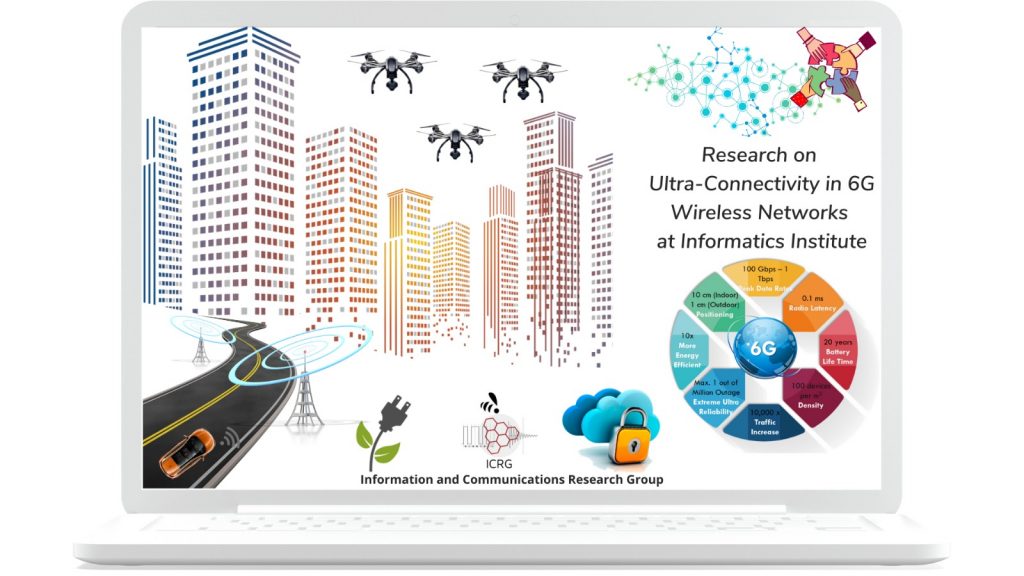
Information and Communications Research Group (ICRG) at Informatics Institute conducts academic and industrial research projects for beyond-5G and 6G next-generation communication networks. Along with that, ICRG publishes in the fields of green communications, NOMA, mobile edge computing, IRS, FSO, and vehicular communications in journals of high impact factors.
| We are heading toward a future where everything is entirely automated and managed remotely. The fast development of new applications like artificial intelligence (AI), virtual reality, three-dimensional (3D) media, and the internet of things (IoT) has led to a vast amount of traffic. Autonomous systems are gaining popularity in a variety of fields, including industry, health, transportation, seas, and space. Millions of sensors will be implanted in cities, automobiles, houses, industries, toys, and other settings to give a smart life and automated systems. As a result, these apps will demand a high data throughput as well as reliable connectivity. Fifth-generation (5G) wireless networks have already been installed in several regions of the world. 5G networks will be unable to create a fully automated and intelligent network that offers everything as a service and a fully immersive experience. To overcome the limitations of 5G for obstacles, a sixth-generation (6G) wireless technology with additional appealing characteristics will be required. The convergence of all previous aspects, such as network densification, high throughput, high dependability, low energy consumption, and huge connection, will be the major drivers of 6G. The 6G system would also carry on the previous generations’ tendencies, which included new services and the introduction of new technology. AI, smart wearables, implants, autonomous vehicles, computing reality gadgets, sensing, and 3D mapping are among the new offerings. The capacity to handle large amounts of data and very high-data-rate connection per device is the most crucial need for 6G wireless networks. In other words, massive connection, low latency, high data rates, extensive coverage, and great dependability are expected to be possible with 6G wireless networks shown in Figure 1. |
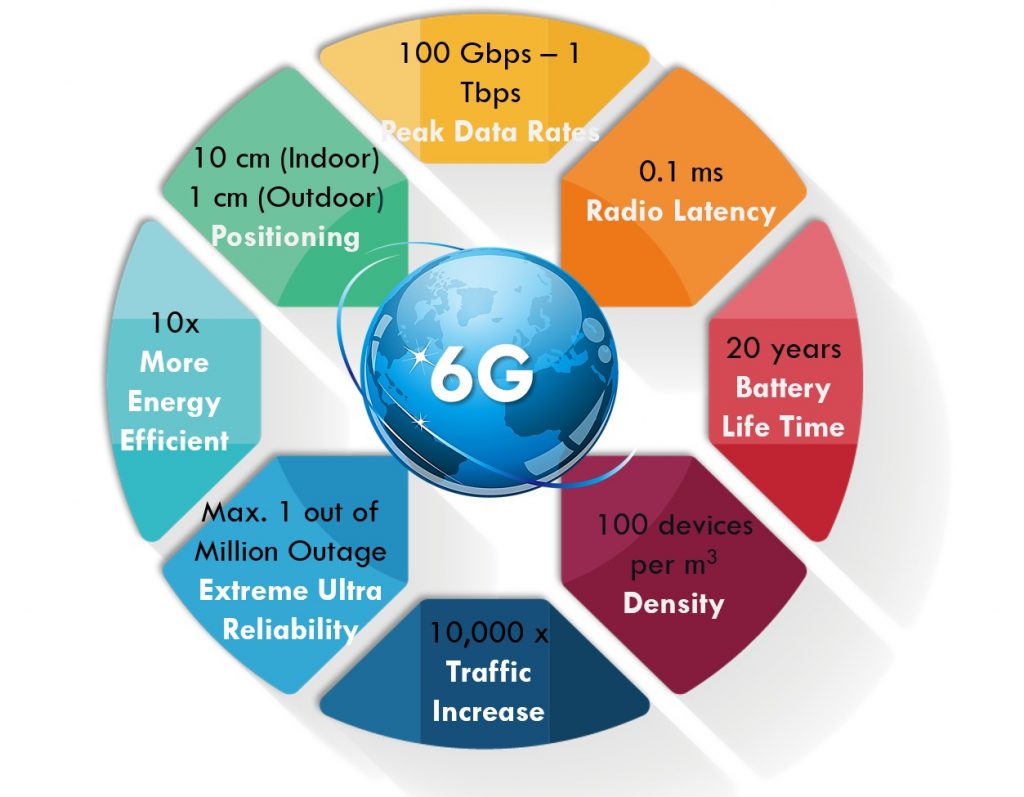
| ICRG Group Our group in the informatics institute mainly focuses on the cutting-edge research field of 6G. Several topics on the 6G fields are given in Figure 1 such as battery lifetime, latency, energy efficiency. Along with that, green communication, NOMA, edge computing, IRS, FSO, and vehicular communications are involved in the scope area of our research topics https://icrg.itu.edu.tr/research/. Being a part of the Informatics Institute, ICRG has 15+ active researchers including a post-doctoral research associate, Ph.D./MS students, and undergraduate students, as well as collaborators from several different universities.” More information on our group is provided at https://icrg.itu.edu.tr. During this year, our group members have published several papers. The published papers in 2021 are listed in the following: M. Namdar, A. Basgumus, S. Aldirmaz-Colak, E. Erdogan, H. Alakoca, S. Ustunbas, and L. Durak-Ata, “Iterative interference alignment with spatial hole sensing in MIMO cognitive radio networks,” Annals Telecommunications, doi: 10.1007/s12243-021-00869-5, 2021. A. B. Ozyurt, M. Basaran, M. Ardanuc, L. Durak-Ata, and H. Yanıkomeroglu, “Intracell frequency band exiling for green wireless networks: implementation, performance metrics, and use cases,” IEEE Vehicular Technology Magazine, vol. 16, no. 2, pp. 31-39, Jun. 2021, doi: 10.1109/MVT.20213057355, 2021. F. Tekçe, U. E. Ayten, and L. Durak-Ata, “SCMA system design with index modulation via codebook assignment,” IEEE Transactions on Vehicular Technology, vol. 70, no. 2, pp. 1699-1708, Feb. 2021, doi: 10.1109/TVT.2021.3055849, 2021. B. Atan, N.Calik, S. Tedik-Basaran, M. Basaran, and L. Durak-Ata, “Learning-based fast decision for task execution in next-generation wireless networks,” IEEE 28th International Conference on Telecommunications (ICT’21), 1-3 Jun. 2021. H. Maleki, M. Basaran, L. Durak-Ata, “Reinforcement learning-based decision-making for vehicular edge computing,” IEEE Signal Proc. Appl. Conf. (SIU’21), 9-11 Jun. 2021. Note: All published papers can be found from the link: https://icrg.itu.edu.tr/publications/ Projects: Since 2019, our group has applied and granted for several projects from different organizations. Some of our sponsors and partners are Presidency of Defence Industries, İTÜ Vodafone Future Lab, İTÜNOVA TTO, Air Inc., ARMERKOM, and ANDASİS. Especially, İTÜ Vodafone Future Lab is a key sponsor in Informatics Institute where it supports about 20 Ph.D./Master students and provides them scholarships to pursue their studies. Until now, eight projects have been completed and currently, four active projects are available where the details of all the active and completed projects can be found in https://icrg.itu.edu.tr/projects/. Additionally, the last accepted and current project is supported by The Scientific and Technological Research Council of Turkey (TUBITAK) in the context of the 1001 program with the title “Ultra-Connectivity for 6G Wireless Communications: UAV and Intelligent Reflective Surface Enabled Heterogeneous Network Design”. A brief explanation of the project is given as follow: Here, we aim to reveal a high-performance vertical HetNet (VhetNet) with unmanned aerial vehicles (UAVs) and intelligent reflecting surfaces (IRS) considering physical layer security. In the context of 6G, networks are anticipated to include not just terrestrial but also flyable network pieces, and hence infrastructure functionality for both terrestrial and non-terrestrial networks would differ significantly. Non-terrestrial networks will be made up of a variety of vertical parts, including satellites and flying base stations equipped with UAVs BSs. In contrast to fixed-position terrestrial BSs, wireless networks utilizing UAVs can ensure communication continuity in unanticipated extreme conditions by working autonomously in hard-to-reach places. In heterogeneous networks (HetNets), intelligent reflecting surfaces (IRS), which are designed as next-generation transceivers, come into focus with low power consumption and secure communication characteristics. In the near future, these communication nodes, which may function as either BSs or users in a network connection, are expected to become increasingly widespread. A reliable, energy-efficient and effective vertical HetNet (VHetNet) architecture is suggested in this project proposal. In the terrestrial HetNet structure, a realistic Poisson point process-based configuration will be built for this purpose. Its goal is to use UAV and IRS to reveal the VHetNet’s energy and communication efficiency, as well as physical layer security, in terms of trajectory, position, and altitude depicted in Figure 2. |
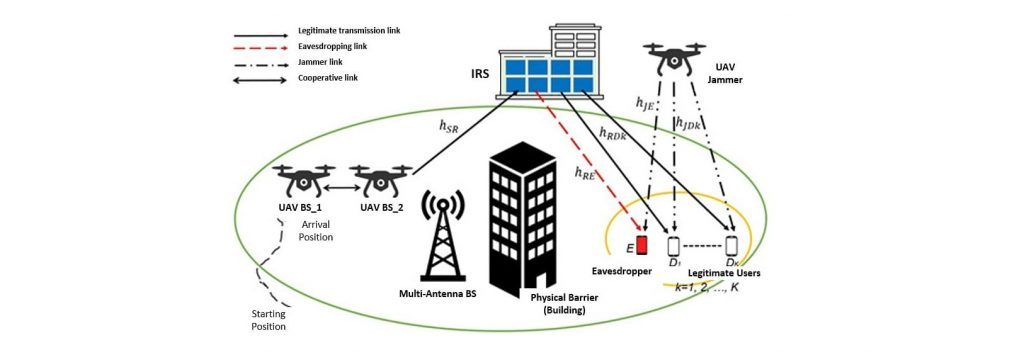
| Research topic: In the context of the 6G research field, we have done several types of research. A brief illustration of some research works which have been submitted/accepted to journals/conferences has been provided in the following. H. Maleki, M. Başaran and L. Durak-Ata, “Reinforcement Learning-Based Decision-Making for Vehicular Edge Computing,” 2021 29th Signal Processing and Communications Applications Conference (SIU), 2021, pp. 1-4, doi: 10.1109/SIU53274.2021.9478026. Generally, internet of things (IoT) devices are restricted by the battery and computational resources and this led to a shift to perform computation offloading to Multi-access edge computing (MEC). In this paper shown in Figure 3, we investigated the MEC in extremely dynamic vehicular environments. To make steady computation offloading decisions, an online learning procedure based on Deep Reinforcement Learning had been proposed, which minimizes the energy consumption and computation delay for vehicles. |
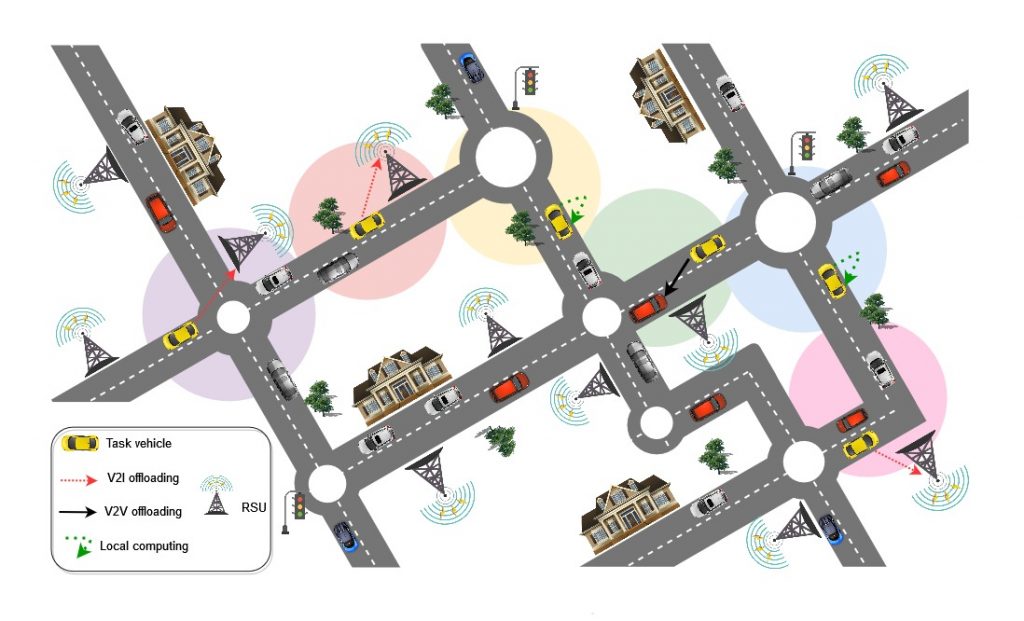
Multiple access techniques are used in wireless communication networks to effectively allocate limited resources to a large number of users. Current cellular communication systems’ well-known orthogonal multiple access (OMA) techniques, such as time division multiple access, frequency division multiple access, or code division multiple access, cannot meet the higher spectral efficiency and enhanced user fairness requirements of 5G and beyond technologies. Non-orthogonal multiple access (NOMA) has recently been presented as an outperforming multiple access technology that provides greater spectral efficiency than OMA techniques by enabling several users to simultaneously transmit their signal with different power levels in the same resource block (i.e, frequency, time, code). Vehicle-to-vehicle (V2V) communications are getting more popular as an important application area of 5G technology due to the opportunities it provides, such as in-vehicle internet access and autonomous driving, as well as intersection management and preventing densities by regulating traffic flow, collision avoidance, and rapid response to accidents, roadway reservation, and increased road safety. V2V communication system design presents unique issues as compared to cellular communication systems. One of them is that the fading effect in wireless communication channels is worse than in cellular communication systems due to factors such as high vehicle speeds, low vehicle antenna heights, and a large number of scattering objects. The fading coefficients of vehicular channels are described as the multiplication of several random variables, and numerous studies in the literature suggest that the double Rayleigh fading model can appropriately characterize this type of channel. In our proposed system, however, V2V channels are subjected to double Rayleigh fading, which is the most accurately fitting fading model for the considered environment. At this point, we emphasize that we propose, for the first time in the literature, to achieve the advantages of NOMA and fixed-gain AF relayed cooperative communication techniques for V2V systems, and then investigate the performance of the proposed system in terms of outage probability and ergodic capacity metrics in Figure 4. |

| A. Ibrahim, S. O. Ata, E. Erdogan, L. Durak-Ata, “Performance analysis of free-space optical communication systems over imprecise Málaga fading channels,” Optics Communications, Vol. 457, 124694, ISSN 0030-4018, doi: 10.1016/j.optcom.2019.124694, 2020 Free space optical (FSO) communication system is a wireless technology that has gained considerable attention in the recent past due to its promise to provide the ultra-high data rate required by the fifth-generation (5G) and beyond 5G wireless networks. FSO communication systems also enjoy a license-free spectrum, higher security compared to their radio frequency (RF) wireless systems counterpart, low cost, and ease of deployment. Due to these advantages, FSO communication systems are proposed as a backhaul/fronthaul framework for 5G and beyond-5G wireless networks. However, despite these attractive features, the reliability of FSO systems is degraded by weather conditions and atmospheric turbulence effect, which is a result of the random changes in atmospheric temperature, pressure, and altitude. Also, the effect of the pointing error which is caused by misalignment of the transmitting and receiving apertures in an FSO system deteriorates the performance of FSO communication systems. Another limiting effect of the performance of FSO communication systems is the channel estimation errors that happen at the receiver side. To realistically evaluate the performance of FSO systems, we consider all these impairing effects to assess the reliability of FSO communication systems in our study. Specifically, we investigate the performance of FSO communication systems employing a BPSK subcarrier intensity modulation (SIM) scheme over imprecise M turbulence channels in the presence of channel estimation errors Figure 5. |
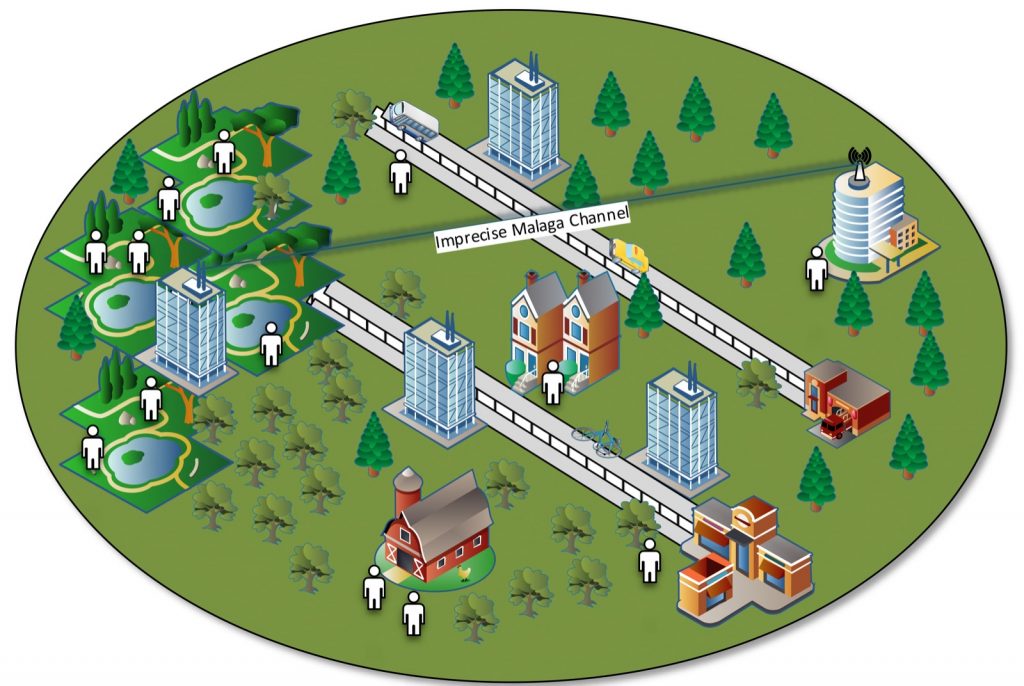
A large number of nodes with numerous antennas will be connected to each other in next-generation wireless communications, and power needs will be a crucial limitation for long-term viability. Wireless energy harvesting (EH) technologies are seen to be among the main promising solutions to these nodes’ energy scarcity problems. Because it replaces the need for batteries and electrical power supply at the sensor nodes, radio frequency (RF) EH provides a small step toward solving the energy shortage in the context of limited energy resources and green communication. We present two nonlinear (NL)-EH models in this study, both of which are mathematically tractable in terms of the PDF, CDF of harvested power, and system performance. The system under consideration consists of a power beacon (PB) from which a power-constrained source harvests energy that is subsequently utilized to send data to a destination Figure 6. Nakagami-m and Rayleigh’s fading is assumed for the channels. When the channels between nodes are stronger and the distances between them are small, the former is assumed. Due to the lack of a line-of-sight component, the link between nodes is vulnerable to the negative effects of the surroundings. Based on the curve fitting of the measurements data, PDF and CDF expressions for the harvested power are derived for both models. Furthermore, the PDF of harvested power is used to obtain the average harvested power. Furthermore, for the proposed two NL-EH models, the outage probability, throughput, and bit error probability (BEP) of the investigated system are derived in closed forms. Because the NL-EH models used in the literature are not mathematically tractable, they do not yield closed-form expressions for system performance. Only the amount of harvested power at the EH receiver is analyzed in the articles that consider these models, with no consideration of the system BEP or throughput performance. As a result, this study makes a significant addition by suggesting two mathematically tractable NL-EH models with an acceptable trade-off in curve fitting accuracy. In terms of system performance, numerical results provide a comprehensive evaluation for all of the investigated EH models. The results reveal that the distance between antennas and the number of antennas have a significant impact on system performance, providing insight into how to maximize system performance. |

| In the physical layer, reconfigurable intelligent surfaces (RIS) are the innovative element for advancing service quality and quality of experience. However, it is essential to ensure secure communications through RIS-enabling networks due to the interconnected potential for communications in next-generation wireless networks considering the information and communications technology (ICT) agenda. On the other hand, PLS-enhanced solutions are the most prominent for 6G communication networks that satisfy cyber-physical system requirements instead of generic methods. Various applications and co-dependencies using RIS-assisted communications have also been possible, such as industrial communications, space communications, body area networks, and interconnected vehicular communications Figure 7. While the conventional possible threats can be widely found in the literature, covering wireless jamming, spoofing, and eavesdropping, a diverse set of novel potential attacks is presented in this article. Although vertical communication systems are planned to improve secrecy, the secure communications of RIS-enabled networks remain critical for defense and space networks due to the stringent safety requirements. Unintended access could be controlled and coordinated with smart surface integrated vertical communication equipment such as satellites and unmanned aerial vehicles, etc. As PLS-aided solutions for RIS-assisted wireless communications are becoming more and more prominent, guaranteeing high reliability and secrecy, enabling ultra-connectivity, and enhancing end-to-end secure communications network performance should be extensively studied for 6G wireless networks. |
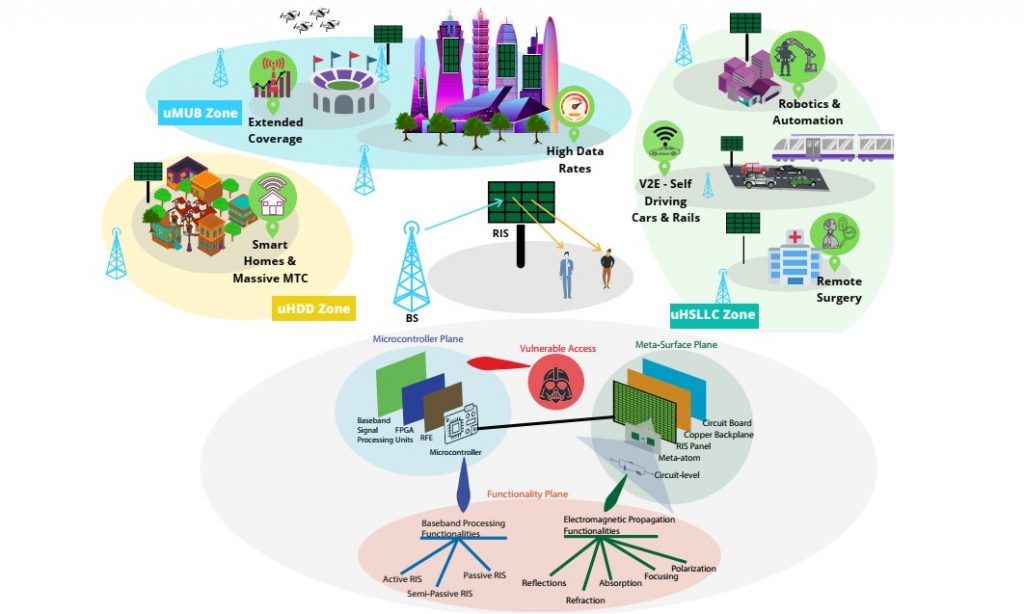
| A. B. Ozyurt, M. Basaran, M. Ardanuc, L. Durak-Ata, and H. Yanıkomeroglu, “Intracell frequency band exiling for green wireless networks: implementation, performance metrics, and use cases,” IEEE Vehicular Technology Magazine, vol. 16, no. 2, pp. 31-39, Jun. 2021, doi: 10.1109/MVT.20213057355, 2021. The tradeoff between spectral efficiency (SE) and energy efficiency (EE) has been remarkable in 5G and beyond wireless networks. In this study, frequency bands of mobile users are assigned from upper‐frequency bands (UFBs) to lower frequency bands (LFBs) by adjusting the coverage area. An environmentally friendly solution with the name of intracell frequency band exiling (ICE) is presented as a technique in which better results have been obtained in terms of both EE & SE than the cell zooming technique Figure. 8. Furthermore, a cell‐exiling manager system for the proposed technique is presented to demonstrate the feasibility of the technique. |

In ICRG, we always try to research the hot topics of academia along with the challenging issues in the industry with our partners and sponsors. Our main continuous focus is to develop and investigate new ways to improve the current wireless system standards to enhance the reliability of the communication systems. There are highly motivated and enthusiastic team members in our group and they are very curious about the new and challenging issues. We are always in search of a passionate and motivated person who could join our group.
